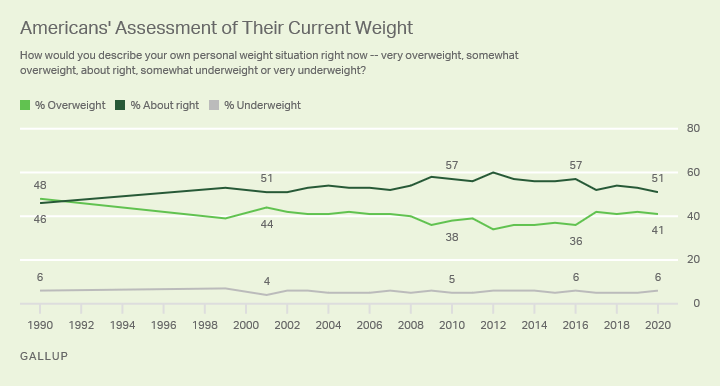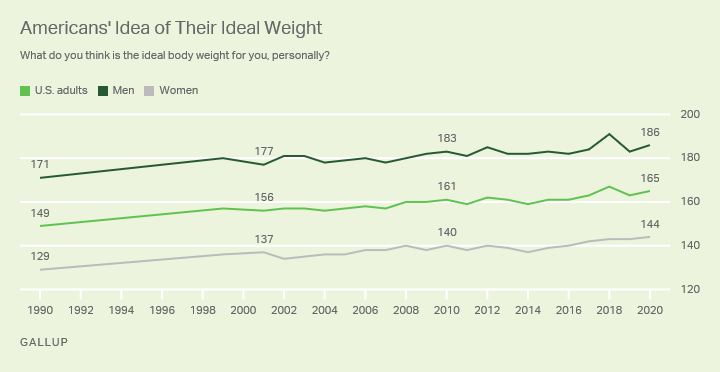Story Highlights
- Proportion of U.S. adults feeling overweight stays near four in 10
- Even higher percentage would like to lose weight, but stable at 55%
- Percentage of women seriously trying to lose weight at record low
WASHINGTON, D.C. -- Americans' self-described weight remains roughly the same as last year with 41% saying they are overweight, similar to the 42% reporting this in 2019. Meanwhile, just over half (now 51%) continue to say their weight is about right, while a small percentage (6%) report being underweight.

Line graph. Trend since 1990 in Americans' view of their weight status. The percentage describing themselves as overweight trended down from 48% in 1990 to 36% in 2016, but has since risen and is 41% in 2020.
The amount that Americans say they weigh also has not changed, averaging 181 pounds among all U.S. adults. Men report being about 20 pounds heavier than that, averaging 200 pounds, while women say they are about 20 pounds lighter than the overall average, at 162 pounds.

Line graph. Trend since 1990 in Americans' self-reported weight. This has gradually increased from an average 161 pounds in 1990 to 181 pounds today. Men and women have shown similar shifts with men's weight rising from 180 to 200 pounds over this period and women's increasing from 142 to 162 pounds.
These findings are from Gallup's November Health and Healthcare poll, conducted this year Nov. 5-19, which has tracked Americans' self-reports of their current weight and desire to lose weight annually since 2001, with occasional trends dating back to the 1990s or earlier.
Majority Still Want to Lose Weight
Along with the stability in Americans' average weight, the percentage who would like to lose weight is unchanged, registering 55% each of the past two years. Most others (38%) would like to maintain their current weight, while 7% want to gain weight.
As is typical, women (59%) are slightly more likely than men (51%) to want to lose weight.

Line graph. Trend since 1990 in Americans' self-reported desire to lose weight. This has gradually remained the same, with 52% in 1990 and 55% today. Women's desire has remained stable, with 61% of women wanting to lose weight in 1990 and 59% today; among men, 42% in 1990 wanted to lose weight, while 51% want to lose weight today.
Effort to Lose Weight Has Waned Among Women
Less than half of those who want to lose weight say they are seriously trying to do so right now -- with the figure at 23% of all U.S. adults, including equal percentages of men and women. This compares with 25% of all adults actively trying to lose weight a year ago, and the average 26% seen in the entire past decade, from 2010 to 2019.
Women have become significantly less likely to say they are working on weight loss in the past year, falling from 29% in 2019 to 23% this year -- their all-time low. The latest decline is also a departure from the average 30% of women who were trying to lose weight during the 2010s. Meanwhile, the current 23% of men attempting weight loss has essentially stayed steady, registering 21% last year and an average 22% in the past decade.

Line graph. Decade averages since 1990 in the percentage of U.S. adults who say they are seriously trying to lose weight. This increased from 21% in the 1990s to 27% from 2001-2009. It held at 26% from 2010-2019 but fell to 23% in 2020. The desire to lose weight has held steady near 22% among since the 2000s while it has decreased among women, falling from 27% to 23%.
Ideal Body Weight Also Unchanged
At the same time, Americans' concept of their ideal body weight is unchanged this year, but remains at the higher end of the historical range following years of gradual increases.
Essentially, as Americans' self-reported weight has increased over the past two decades, so has their vision of what their perfect weight should be -- and the 144 pounds that women, on average, identify as their ideal figure is the highest yet.

Line graph. Trend since 1990 in Americans view of their ideal weight in pounds. This has gradually increased from 149 in 1990 to 165 in 2020. Similar increases are seen among men and women, women rising from 129 to 144 pounds and men from 1717 to 186 pounds.
Bottom Line
Despite the risk that various changes in people's lives and limits on their mobility created by the pandemic would lead to significant weight gain, this has not occurred according to Americans' own reports on their weight. But nor have Americans, en masse, used the situation -- including the forced reduction in dining out -- to achieve their weight loss goals.
The stability in Americans' average weight over the past year likely reflects a lack of weight change for most people. But that apparent steadiness may also mask opposing storylines. While some may have found it easier to diet and exercise during the pandemic, possibly shedding unwanted pounds, others may have become more sedentary while switching to remote work or school and struggled to avoid the temptations of overeating at home, thus gaining weight.
View complete question responses and trends (PDF download).
Learn more about how the Gallup Poll Social Series works.




